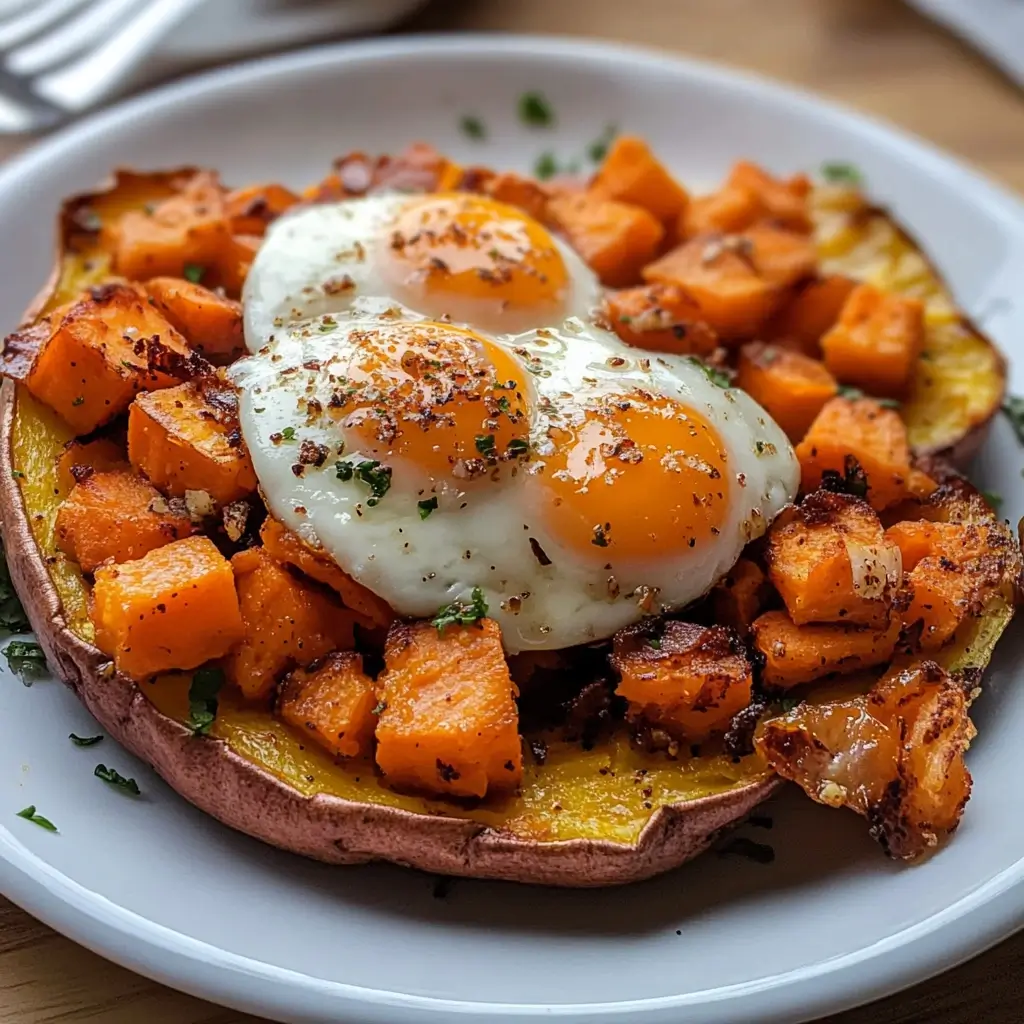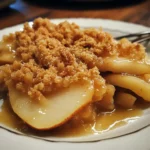Breakfast. It’s the most important meal of the day, they say, and for good reason. But in the whirlwind of busy mornings, it’s often the first thing to get sacrificed for speed and convenience. For years, our family breakfast routine was a predictable cycle of toast, cereal, and the occasional rushed pancake attempt. Don’t get me wrong, these are classics, but I yearned for something more nourishing, something that would truly fuel our bodies and kickstart our day with energy and flavour. That’s when I stumbled upon the idea of breakfast sweet potatoes. Initially, the concept seemed a little… unconventional. Sweet potatoes for breakfast? Were we venturing into dessert territory? But curiosity, and a desire to inject some healthy variety into our mornings, prevailed.
The first time I made breakfast sweet potatoes, the aroma alone was enough to pique everyone’s interest. The sweet, earthy scent of roasting sweet potatoes mingled with the savory notes of cinnamon and a hint of maple syrup, creating a breakfast symphony that was both comforting and enticing. Topped with a medley of crispy bacon, a perfectly fried egg, and a dollop of creamy Greek yogurt, these weren’t just sweet potatoes; they were a breakfast revelation. My kids, initially skeptical, devoured them. My husband, a staunch savory breakfast devotee, was converted. And me? I was thrilled to have discovered a breakfast that was not only incredibly delicious but also packed with nutrients and surprisingly versatile. Breakfast sweet potatoes have become a staple in our home, a blank canvas for culinary creativity, and a guaranteed way to start our day on a happy and healthy note. If you’re looking to break free from breakfast boredom and discover a dish that’s both nourishing and exciting, look no further. This recipe is about to become your new morning obsession.
Ingredients
This recipe is incredibly flexible, allowing you to tailor it to your dietary needs and taste preferences. Here’s a breakdown of the core ingredients and some delicious variations to inspire you:
For the Sweet Potato Base:
- Sweet Potatoes: 2 medium-sized sweet potatoes, about 6-8 inches long, washed and scrubbed. Choose firm sweet potatoes with smooth skin for the best roasting results. You can use garnet, jewel, or even Japanese sweet potatoes – each variety offers a slightly different sweetness and texture.
- Olive Oil or Coconut Oil: 1 tablespoon. Olive oil adds a subtle savory note, while coconut oil imparts a hint of sweetness and tropical aroma. Both are healthy fats that enhance the roasting process and add flavor. Avocado oil is another excellent neutral-flavored option.
- Spices (Optional, but Recommended):
- Cinnamon: ½ teaspoon. Cinnamon enhances the natural sweetness of the sweet potatoes and adds a warm, comforting flavor.
- Nutmeg: ¼ teaspoon (freshly grated is best!). Nutmeg adds a subtle warmth and depth of flavor that complements cinnamon beautifully.
- Ginger Powder: ¼ teaspoon (optional). Ginger adds a touch of zing and warmth, especially lovely in colder months.
- Salt: A pinch, to balance the sweetness and enhance the flavors.
- Black Pepper: A pinch, to add a subtle savory counterpoint.
Toppings – Savory Options (Choose your favorites or mix and match!):
- Eggs: 2-4 large eggs, cooked to your preference (fried, scrambled, poached, or even a sunny-side up). Eggs provide protein and richness, making the breakfast more substantial.
- Bacon or Sausage: 4-6 slices of cooked bacon, crumbled, or ½ cup cooked and crumbled sausage (turkey, chicken, or pork). Adds smoky, savory flavor and protein. Consider turkey or chicken sausage for a leaner option.
- Avocado: ½ ripe avocado, sliced or diced. Adds creaminess, healthy fats, and a vibrant green color.
- Black Beans or Chickpeas: ½ cup cooked and rinsed black beans or chickpeas, warmed through. Adds fiber, protein, and a hearty texture. Season with a pinch of cumin or chili powder for extra flavor.
- Salsa or Pico de Gallo: 2-4 tablespoons. Adds freshness, acidity, and a spicy kick. Choose your favorite level of spice.
- Cheese: 2-4 tablespoons shredded cheese (cheddar, Monterey Jack, feta, goat cheese). Adds flavor and creaminess. Consider crumbled feta or goat cheese for a tangy twist.
- Green Onions or Chives: 1-2 tablespoons, chopped. Adds a fresh, mild oniony flavor and a pop of green.
- Hot Sauce: To taste. For those who like a spicy breakfast, a dash of hot sauce adds a welcome kick.
Toppings – Sweet Options (Choose your favorites or mix and match!):
- Greek Yogurt or Coconut Yogurt: ½ cup. Adds creaminess, protein, and a tangy counterpoint to the sweetness. Coconut yogurt is a great dairy-free alternative.
- Maple Syrup or Honey: 1-2 tablespoons. Adds extra sweetness and a lovely glaze. Agave nectar or date syrup are other natural sweetener options.
- Berries: ½ cup fresh or frozen berries (blueberries, raspberries, strawberries, blackberries). Adds antioxidants, sweetness, and a burst of freshness.
- Sliced Banana or Apple: ½ banana or apple, sliced. Adds natural sweetness and fiber. Sautéed apples with cinnamon are particularly delicious.
- Nuts and Seeds: ¼ cup chopped nuts (walnuts, pecans, almonds) or seeds (chia seeds, pumpkin seeds, sunflower seeds). Adds crunch, healthy fats, and protein. Toasted nuts offer a richer flavor.
- Granola: ¼ cup. Adds crunch and sweetness. Choose a granola with whole grains and minimal added sugar.
- Nut Butter: 1-2 tablespoons (peanut butter, almond butter, cashew butter). Adds protein, healthy fats, and a creamy texture.
- Shredded Coconut: 1-2 tablespoons unsweetened shredded coconut. Adds a tropical flavor and texture.
- Chocolate Chips or Cacao Nibs: 1-2 tablespoons (dark chocolate or cacao nibs for a healthier option). Adds a touch of indulgence.
Ingredient Notes:
- Sweet Potato Size: Medium sweet potatoes are ideal for individual servings. Adjust the number of sweet potatoes based on the number of servings you need.
- Spice Customization: Feel free to experiment with other spices like smoked paprika, cumin, or chili powder for a different flavor profile.
- Dietary Adaptations: This recipe is naturally gluten-free and can easily be made vegan by choosing plant-based toppings. Adjust toppings to suit your dietary needs (low-carb, dairy-free, etc.).
- Fresh vs. Frozen: Fresh toppings are generally preferred, but frozen berries are a convenient and affordable option, especially in the off-season. Just thaw them slightly before using.
Instructions
Making breakfast sweet potatoes is surprisingly simple and requires minimal active cooking time. Here’s a step-by-step guide to create this delicious and nutritious breakfast:
Step 1: Prepare the Sweet Potatoes (Preheat Oven)
- Preheat your oven to 400°F (200°C). This temperature is ideal for roasting sweet potatoes until they are tender and slightly caramelized.
- Wash and scrub the sweet potatoes thoroughly under cold running water. Remove any dirt or blemishes. Pat them dry with a clean kitchen towel or paper towels.
- Pierce the sweet potatoes several times with a fork. This allows steam to escape during cooking and prevents them from bursting in the oven.
- Optional: Cut the sweet potatoes in half lengthwise. Cutting them in half will reduce the roasting time and make them easier to scoop out later. If you prefer to keep them whole, they will take a bit longer to cook.
Step 2: Season and Roast the Sweet Potatoes
- Place the sweet potatoes (whole or halved) on a baking sheet. Line the baking sheet with parchment paper for easier cleanup if desired, although it’s not strictly necessary.
- Drizzle the sweet potatoes with olive oil or coconut oil. Use your hands to rub the oil evenly over the entire surface of each sweet potato.
- Sprinkle with your chosen spices (cinnamon, nutmeg, ginger, salt, pepper). Ensure the spices are distributed evenly. If you are using salt and pepper, a light sprinkle is sufficient, as you can always add more later.
- Roast in the preheated oven for 45-60 minutes for whole sweet potatoes, or 30-40 minutes for halved sweet potatoes. Roasting time will vary depending on the size of your sweet potatoes and your oven.
- Check for doneness. The sweet potatoes are done when they are easily pierced with a fork and feel soft when gently squeezed. The skin should be slightly wrinkled and the flesh should be tender.
Step 3: Prepare Your Toppings While Sweet Potatoes Roast
- While the sweet potatoes are roasting, prepare your chosen toppings. This is the perfect time to cook bacon or sausage, fry or scramble eggs, chop vegetables, prepare salsa, or gather your sweet toppings like yogurt, berries, and nuts. Efficiently preparing your toppings while the sweet potatoes roast maximizes your time in the kitchen.
- Warm any pre-cooked toppings that need to be heated. For example, warm black beans or chickpeas in a saucepan or microwave.
Step 4: Assemble and Serve Your Breakfast Sweet Potatoes
- Once the sweet potatoes are roasted and tender, remove them from the oven. Allow them to cool slightly so you can handle them comfortably.
- If you roasted them whole, slice them lengthwise down the middle. If you roasted them halved, they are already ready to be topped.
- Scoop out a portion of the sweet potato flesh, leaving a “bowl” shape in the skin. This creates a perfect vessel for your toppings. You can also simply slice or mash the sweet potato flesh if you prefer.
- Load up your sweet potatoes with your desired toppings. Start with a base of savory or sweet toppings, then layer on additional ingredients to create your perfect breakfast sweet potato bowl.
- Serve immediately and enjoy! Breakfast sweet potatoes are best enjoyed warm, right after they are assembled.
Cooking Tips for Success:
- Don’t overcook the sweet potatoes. Overcooked sweet potatoes can become mushy. Check for doneness regularly towards the end of the roasting time.
- Roast at the right temperature. 400°F (200°C) is the sweet spot for roasting sweet potatoes. Higher temperatures can burn the outside before the inside is cooked.
- Season generously. Don’t be shy with your spices and seasonings. They are key to enhancing the flavor of the sweet potatoes and creating a balanced breakfast.
- Get creative with toppings. The beauty of breakfast sweet potatoes is their versatility. Experiment with different combinations of savory and sweet toppings to find your favorites.
- Make it ahead of time. You can roast the sweet potatoes ahead of time and store them in the refrigerator. Reheat them in the microwave or oven and add fresh toppings just before serving.
Nutrition Facts
(Per serving, based on 1 medium sweet potato with basic savory toppings – egg, bacon, avocado, and a dollop of Greek yogurt. Nutritional values are estimates and can vary depending on specific ingredients and portion sizes.)
- Serving Size: 1 stuffed sweet potato
- Calories: Approximately 450-550 calories
- Protein: 20-25 grams
- Fat: 25-35 grams (primarily healthy fats from avocado, olive oil, and egg yolk)
- Saturated Fat: 5-8 grams (depending on bacon and cheese choices)
- Cholesterol: 180-220 mg (primarily from egg yolk)
- Sodium: 300-500 mg (depending on bacon, sausage, and cheese choices)
- Carbohydrates: 50-60 grams
- Fiber: 8-10 grams
- Sugar: 15-20 grams (naturally occurring sugars in sweet potato)
- Vitamin A: Excellent source (over 200% of Daily Value)
- Vitamin C: Good source (around 30% of Daily Value)
- Potassium: Good source (around 20% of Daily Value)
- Iron: Moderate source (around 10% of Daily Value)
Nutritional Highlights:
- High in Fiber: Sweet potatoes are an excellent source of dietary fiber, which aids in digestion, promotes satiety, and helps regulate blood sugar levels.
- Rich in Vitamins and Minerals: Packed with Vitamin A (beta-carotene), Vitamin C, potassium, and other essential nutrients.
- Good Source of Healthy Fats and Protein: With the addition of toppings like eggs, avocado, nuts, and yogurt, this breakfast provides a balanced source of healthy fats and protein to keep you full and energized.
- Antioxidant-Rich: Sweet potatoes are loaded with antioxidants, which help protect your body against cell damage.
- Complex Carbohydrates for Sustained Energy: Sweet potatoes provide complex carbohydrates that are digested slowly, providing sustained energy throughout the morning without a rapid blood sugar spike.
Note: These nutrition facts are approximate and can vary based on the specific ingredients and toppings you choose. For precise nutritional information, use a nutrition calculator and enter the exact ingredients you use.
Preparation Time
- Prep Time: 10-15 minutes (washing, scrubbing, and prepping sweet potatoes and toppings)
- Cook Time: 45-60 minutes for whole sweet potatoes, 30-40 minutes for halved sweet potatoes (roasting time)
- Total Time: 55-75 minutes for whole sweet potatoes, 40-55 minutes for halved sweet potatoes
Make-Ahead Options:
- Roast Sweet Potatoes in Advance: Sweet potatoes can be roasted ahead of time and stored in the refrigerator for up to 3-4 days. Reheat them in the microwave or oven until warmed through before adding toppings. This is a great time-saving tip for busy mornings.
- Prepare Toppings Ahead: Many toppings can be prepped in advance. Cook bacon or sausage, chop vegetables, and prepare sauces or dips the day before. Store them separately in airtight containers in the refrigerator.
- Assemble Ahead (Partially): You can even partially assemble the breakfast sweet potatoes by stuffing the roasted sweet potatoes with some of the toppings (like black beans or cheese) and then reheating them before adding fresher toppings like eggs and avocado.
How to Serve
Breakfast sweet potatoes are incredibly versatile and can be served in numerous delicious ways. Here are some ideas to get you started:
Savory Serving Suggestions:
- Classic Savory Bowl: Top with a fried egg, crispy bacon crumbles, diced avocado, a dollop of Greek yogurt, and a sprinkle of green onions.
- Southwestern Fiesta: Fill with black beans, salsa, shredded cheddar cheese, a fried egg, and a dollop of sour cream or guacamole.
- Mediterranean Delight: Top with crumbled feta cheese, sun-dried tomatoes, Kalamata olives, a poached egg, and a drizzle of olive oil.
- Breakfast Chili Bowl: Spoon warm chili (vegetarian or with meat) into the sweet potato, top with shredded cheese and a dollop of sour cream.
- Italian Inspired: Top with sautéed spinach, Italian sausage crumbles, ricotta cheese, and a sprinkle of Parmesan cheese.
- Breakfast Burrito Bowl Style: Fill with scrambled eggs, black beans, rice (optional), salsa, guacamole, and shredded cheese.
Sweet Serving Suggestions:
- Berry Yogurt Parfait: Top with Greek yogurt or coconut yogurt, mixed berries (blueberries, raspberries, strawberries), granola, and a drizzle of maple syrup or honey.
- Apple Cinnamon Crumble: Top with sautéed apples with cinnamon, granola crumble, chopped walnuts or pecans, and a dollop of yogurt or whipped cream (optional).
- Peanut Butter Banana Bliss: Top with sliced banana, peanut butter or almond butter, granola, chia seeds, and a drizzle of honey.
- Tropical Sunrise: Top with coconut yogurt, mango chunks, pineapple chunks, shredded coconut, and macadamia nuts.
- Chocolate Peanut Butter Dream: Top with peanut butter, chocolate chips or cacao nibs, sliced banana, and a sprinkle of sea salt.
- Pumpkin Spice Delight: Top with pumpkin puree (spiced with cinnamon, nutmeg, ginger), granola, pecans, and a dollop of whipped cream or yogurt.
Serving Tips:
- Serve Warm: Breakfast sweet potatoes are best served warm, right after they are roasted and topped.
- Individual Bowls: Serve each sweet potato as an individual bowl for a satisfying and visually appealing breakfast.
- Buffet Style: For a brunch or family gathering, set up a “sweet potato bar” with roasted sweet potatoes and a variety of toppings for everyone to customize their own bowls.
- Side Dish Option: Roasted sweet potatoes can also be served as a delicious and healthy side dish alongside other breakfast or brunch items.
Additional Tips
Here are 5 helpful tips to elevate your breakfast sweet potato experience:
- Roast for Maximum Sweetness: Roasting sweet potatoes brings out their natural sweetness and caramelizes their edges. For an even sweeter flavor, try roasting them at a slightly lower temperature (375°F or 190°C) for a longer period (around 75-90 minutes for whole sweet potatoes). This low and slow roasting method allows the natural sugars to develop fully.
- Don’t Skip the Spices: Spices are your secret weapon to adding depth and complexity to your breakfast sweet potatoes. Experiment with different spice combinations beyond cinnamon and nutmeg. Try smoked paprika for a smoky savory flavor, cumin for a warm earthy note, or chili powder for a subtle kick. A pinch of cardamom or cloves can also add a unique aromatic dimension.
- Toast Your Nuts and Seeds: Toasting nuts and seeds before adding them as toppings enhances their flavor and texture significantly. Simply spread them on a baking sheet and toast in a 350°F (175°C) oven for 5-10 minutes, or until lightly golden and fragrant. Watch them closely to prevent burning. Toasted nuts and seeds add a delightful crunch and nutty aroma to your breakfast bowl.
- Reheat Sweet Potatoes Properly: If you’re reheating roasted sweet potatoes, the best way to maintain their texture and flavor is to reheat them in the oven or toaster oven. Wrap them in foil and reheat at 350°F (175°C) for about 15-20 minutes, or until warmed through. Microwaving can make them slightly mushy, but it’s a quicker option if you’re short on time. If microwaving, reheat in short intervals to avoid overheating.
- Embrace Leftovers Creatively: Leftover roasted sweet potatoes are incredibly versatile. Don’t limit them to breakfast! Use them in salads, soups, tacos, or even as a side dish for dinner. Mashed leftover sweet potatoes can be incorporated into muffins, pancakes, or sweet potato bread. Get creative and minimize food waste by repurposing your leftover sweet potatoes in delicious and unexpected ways.
FAQ Section
Q1: Can I cook sweet potatoes in the microwave instead of roasting?
A: Yes, you can microwave sweet potatoes for a quicker cooking method, but roasting yields a much better flavor and texture. To microwave, pierce the sweet potato several times with a fork and microwave on high for 5-8 minutes, or until tender. However, microwaving will result in a softer, less caramelized sweet potato compared to roasting. Roasting is highly recommended for optimal taste and texture.
Q2: Can I make breakfast sweet potatoes ahead of time for meal prep?
A: Absolutely! Roasting sweet potatoes ahead of time is a fantastic meal prep strategy. Roast a batch of sweet potatoes on the weekend and store them in the refrigerator for up to 3-4 days. Reheat them as needed and add fresh toppings for a quick and healthy breakfast throughout the week. Prepping toppings in advance also saves time on busy mornings.
Q3: What are some good vegan topping options for breakfast sweet potatoes?
A: There are tons of delicious vegan topping options! Consider: black beans, chickpeas, avocado, salsa, pico de gallo, vegan cheese shreds, tofu scramble, sautéed vegetables (spinach, mushrooms, onions), nuts and seeds, granola, nut butter, berries, banana, maple syrup, agave nectar, coconut yogurt, shredded coconut, and cacao nibs. Get creative and explore the vast world of plant-based toppings!
Q4: Can I use different types of sweet potatoes for this recipe?
A: Yes, you can use different varieties of sweet potatoes. Garnet, jewel, and Japanese sweet potatoes are all excellent choices. Each type offers slightly different levels of sweetness and moisture content. Japanese sweet potatoes tend to be less sweet and drier, while garnet and jewel are sweeter and moister. Experiment to find your favorite!
Q5: My sweet potatoes are taking longer than expected to roast. What should I do?
A: Roasting time can vary depending on the size of your sweet potatoes and your oven’s calibration. If your sweet potatoes are taking longer than expected, ensure your oven is at the correct temperature. If they are browning too quickly on the outside but still hard inside, reduce the oven temperature slightly (to 375°F or 190°C) and continue roasting until tender. You can also tent them loosely with foil to prevent further browning while they finish cooking through. Always check for doneness by piercing with a fork – they should be easily pierced and feel soft.
Print
Breakfast Sweet Potato Recipe
Ingredients
For the Sweet Potato Base:
- Sweet Potatoes: 2 medium-sized sweet potatoes, about 6-8 inches long, washed and scrubbed. Choose firm sweet potatoes with smooth skin for the best roasting results. You can use garnet, jewel, or even Japanese sweet potatoes – each variety offers a slightly different sweetness and texture.
- Olive Oil or Coconut Oil: 1 tablespoon. Olive oil adds a subtle savory note, while coconut oil imparts a hint of sweetness and tropical aroma. Both are healthy fats that enhance the roasting process and add flavor. Avocado oil is another excellent neutral-flavored option.
- Spices (Optional, but Recommended):
- Cinnamon: ½ teaspoon. Cinnamon enhances the natural sweetness of the sweet potatoes and adds a warm, comforting flavor.
- Nutmeg: ¼ teaspoon (freshly grated is best!). Nutmeg adds a subtle warmth and depth of flavor that complements cinnamon beautifully.
- Ginger Powder: ¼ teaspoon (optional). Ginger adds a touch of zing and warmth, especially lovely in colder months.
- Salt: A pinch, to balance the sweetness and enhance the flavors.
- Black Pepper: A pinch, to add a subtle savory counterpoint.
Toppings – Savory Options (Choose your favorites or mix and match!):
- Eggs: 2-4 large eggs, cooked to your preference (fried, scrambled, poached, or even a sunny-side up). Eggs provide protein and richness, making the breakfast more substantial.
- Bacon or Sausage: 4-6 slices of cooked bacon, crumbled, or ½ cup cooked and crumbled sausage (turkey, chicken, or pork). Adds smoky, savory flavor and protein. Consider turkey or chicken sausage for a leaner option.
- Avocado: ½ ripe avocado, sliced or diced. Adds creaminess, healthy fats, and a vibrant green color.
- Black Beans or Chickpeas: ½ cup cooked and rinsed black beans or chickpeas, warmed through. Adds fiber, protein, and a hearty texture. Season with a pinch of cumin or chili powder for extra flavor.
- Salsa or Pico de Gallo: 2-4 tablespoons. Adds freshness, acidity, and a spicy kick. Choose your favorite level of spice.
- Cheese: 2-4 tablespoons shredded cheese (cheddar, Monterey Jack, feta, goat cheese). Adds flavor and creaminess. Consider crumbled feta or goat cheese for a tangy twist.
- Green Onions or Chives: 1-2 tablespoons, chopped. Adds a fresh, mild oniony flavor and a pop of green.
- Hot Sauce: To taste. For those who like a spicy breakfast, a dash of hot sauce adds a welcome kick.
Toppings – Sweet Options (Choose your favorites or mix and match!):
- Greek Yogurt or Coconut Yogurt: ½ cup. Adds creaminess, protein, and a tangy counterpoint to the sweetness. Coconut yogurt is a great dairy-free alternative.
- Maple Syrup or Honey: 1-2 tablespoons. Adds extra sweetness and a lovely glaze. Agave nectar or date syrup are other natural sweetener options.
- Berries: ½ cup fresh or frozen berries (blueberries, raspberries, strawberries, blackberries). Adds antioxidants, sweetness, and a burst of freshness.
- Sliced Banana or Apple: ½ banana or apple, sliced. Adds natural sweetness and fiber. Sautéed apples with cinnamon are particularly delicious.
- Nuts and Seeds: ¼ cup chopped nuts (walnuts, pecans, almonds) or seeds (chia seeds, pumpkin seeds, sunflower seeds). Adds crunch, healthy fats, and protein. Toasted nuts offer a richer flavor.
- Granola: ¼ cup. Adds crunch and sweetness. Choose a granola with whole grains and minimal added sugar.
- Nut Butter: 1-2 tablespoons (peanut butter, almond butter, cashew butter). Adds protein, healthy fats, and a creamy texture.
- Shredded Coconut: 1-2 tablespoons unsweetened shredded coconut. Adds a tropical flavor and texture.
- Chocolate Chips or Cacao Nibs: 1-2 tablespoons (dark chocolate or cacao nibs for a healthier option). Adds a touch of indulgence.
Instructions
Step 1: Prepare the Sweet Potatoes (Preheat Oven)
- Preheat your oven to 400°F (200°C). This temperature is ideal for roasting sweet potatoes until they are tender and slightly caramelized.
- Wash and scrub the sweet potatoes thoroughly under cold running water. Remove any dirt or blemishes. Pat them dry with a clean kitchen towel or paper towels.
- Pierce the sweet potatoes several times with a fork. This allows steam to escape during cooking and prevents them from bursting in the oven.
- Optional: Cut the sweet potatoes in half lengthwise. Cutting them in half will reduce the roasting time and make them easier to scoop out later. If you prefer to keep them whole, they will take a bit longer to cook.
Step 2: Season and Roast the Sweet Potatoes
- Place the sweet potatoes (whole or halved) on a baking sheet. Line the baking sheet with parchment paper for easier cleanup if desired, although it’s not strictly necessary.
- Drizzle the sweet potatoes with olive oil or coconut oil. Use your hands to rub the oil evenly over the entire surface of each sweet potato.
- Sprinkle with your chosen spices (cinnamon, nutmeg, ginger, salt, pepper). Ensure the spices are distributed evenly. If you are using salt and pepper, a light sprinkle is sufficient, as you can always add more later.
- Roast in the preheated oven for 45-60 minutes for whole sweet potatoes, or 30-40 minutes for halved sweet potatoes. Roasting time will vary depending on the size of your sweet potatoes and your oven.
- Check for doneness. The sweet potatoes are done when they are easily pierced with a fork and feel soft when gently squeezed. The skin should be slightly wrinkled and the flesh should be tender.
Step 3: Prepare Your Toppings While Sweet Potatoes Roast
- While the sweet potatoes are roasting, prepare your chosen toppings. This is the perfect time to cook bacon or sausage, fry or scramble eggs, chop vegetables, prepare salsa, or gather your sweet toppings like yogurt, berries, and nuts. Efficiently preparing your toppings while the sweet potatoes roast maximizes your time in the kitchen.
- Warm any pre-cooked toppings that need to be heated. For example, warm black beans or chickpeas in a saucepan or microwave.
Step 4: Assemble and Serve Your Breakfast Sweet Potatoes
- Once the sweet potatoes are roasted and tender, remove them from the oven. Allow them to cool slightly so you can handle them comfortably.
- If you roasted them whole, slice them lengthwise down the middle. If you roasted them halved, they are already ready to be topped.
- Scoop out a portion of the sweet potato flesh, leaving a “bowl” shape in the skin. This creates a perfect vessel for your toppings. You can also simply slice or mash the sweet potato flesh if you prefer.
- Load up your sweet potatoes with your desired toppings. Start with a base of savory or sweet toppings, then layer on additional ingredients to create your perfect breakfast sweet potato bowl.
- Serve immediately and enjoy! Breakfast sweet potatoes are best enjoyed warm, right after they are assembled.
Nutrition
- Serving Size: one normal portion
- Calories: 450-550
- Sugar: 15-20 grams
- Sodium: 300-500 mg
- Fat: 25-35 grams
- Saturated Fat: 5-8 grams
- Carbohydrates: 50-60 grams
- Fiber: 8-10 grams
- Protein: 20-25 grams
- Cholesterol: 180-220 mg





